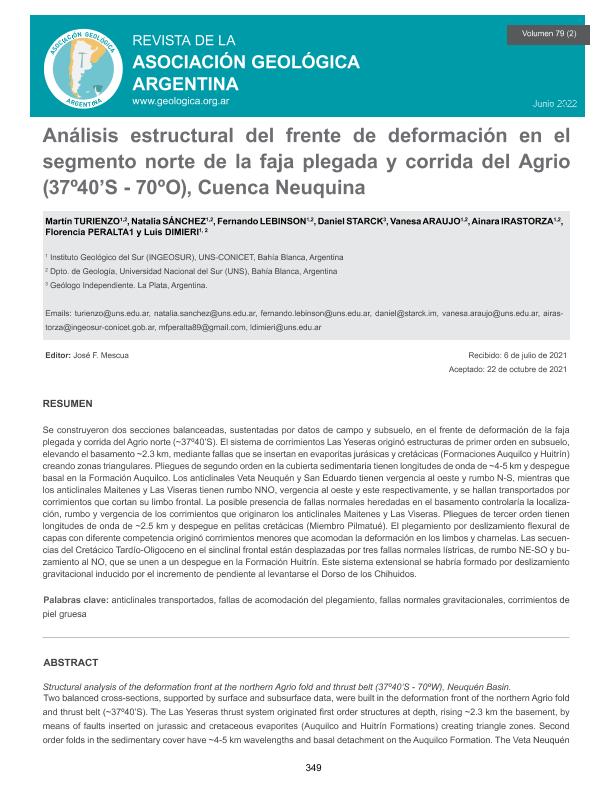Artículo
Se construyeron dos secciones balanceadas, sustentadas por datos de campo y subsuelo, en el frente de deformación de la faja plegada y corrida del Agrio norte (~37º40?S). El sistema de corrimientos Las Yeseras originó estructuras de primer orden en subsuelo, elevando el basamento ~2.3 km, mediante fallas que se insertan en evaporitas jurásicas y cretácicas (Formaciones Auquilco y Huitrín) creando zonas triangulares. Pliegues de segundo orden en la cubierta sedimentaria tienen longitudes de onda de ~4-5 km y despegue basal en la Formación Auquilco. Los anticlinales Veta Neuquén y San Eduardo tienen vergencia al oeste y rumbo N-S, mientras que los anticlinales Maitenes y Las Viseras tienen rumbo NNO, vergencia al oeste y este respectivamente, y se hallan transportados por corrimientos que cortan su limbo frontal. La posible presencia de fallas normales heredadas en el basamento controlaría la localización, rumbo y vergencia de los corrimientos que originaron los anticlinales Maitenes y Las Viseras. Pliegues de tercer orden tienen longitudes de onda de ~2.5 km y despegue en pelitas cretácicas (Miembro Pilmatué). El plegamiento por deslizamiento flexural de capas con diferente competencia originó corrimientos menores que acomodan la deformación en los limbos y charnelas. Las secuencias del Cretácico Tardío-Oligoceno en el sinclinal frontal están desplazadas por tres fallas normales lístricas, de rumbo NE-SO y buzamiento al NO, que se unen a un despegue en la Formación Huitrín. Este sistema extensional se habría formado por deslizamiento gravitacional inducido por el incremento de pendiente al levantarse el Dorso de los Chihuidos. Structural analysis of the deformation front at the northern Agrio fold and thrust belt (37º40’S - 70ºW), Neuquén Basin. Two balanced cross-sections, supported by surface and subsurface data, were built in the deformation front of the northern Agrio fold and thrust belt (~37º40’S). The Las Yeseras thrust system originated first order structures at depth, rising ~2.3 km the basement, by means of faults inserted on jurassic and cretaceous evaporites (Auquilco and Huitrín Formations) creating triangle zones. Second order folds in the sedimentary cover have ~4-5 km wavelengths and basal detachment on the Auquilco Formation. The Veta Neuquén and San Eduardo anticlines have west-vergence and N-S trend, while the Maitenes and Las Viseras anticlines have NNW trend, west and east vergence respectively, and both are transported by thrusts that cut their forelimbs. The possible presence of inherited normal faults in the basement would control the location, trend and vergence of thrust originating the Maitenes and Las Viseras anticlines. Third order folds have ~2.5 km wavelengths and a detachment on cretaceous shales (Pilmatué Member). Flexural slip folding of layers with different competence originated minor fold-accommodation thrusts in the limbs and hinges. Late Cretaceous-Oligocene sequences in the frontal syncline are displaced by three lístric normal faults, of NE-SW trend and dipping to the NW, that join to a decollement on the Huitrín Formation. This extensional system would be formed by gravitational gliding induced by the increasing slope caused by the uplift of the Dorso de los Chihuidos.
Análisis estructural del frente de deformación en el segmento norte de la faja plegada y corrida del Agrio (37º40?S - 70ºO), Cuenca Neuquina
Turienzo, Martin Miguel ; Sánchez, Natalia Paola
; Sánchez, Natalia Paola ; Lebinson, Fernando Oscar
; Lebinson, Fernando Oscar ; Starck, Daniel; Araujo, Vanesa Soledad
; Starck, Daniel; Araujo, Vanesa Soledad ; Irastorza, Ainara
; Irastorza, Ainara ; Peralta, Maria Florencia
; Peralta, Maria Florencia ; Dimieri, Luis Vicente
; Dimieri, Luis Vicente
 ; Sánchez, Natalia Paola
; Sánchez, Natalia Paola ; Lebinson, Fernando Oscar
; Lebinson, Fernando Oscar ; Starck, Daniel; Araujo, Vanesa Soledad
; Starck, Daniel; Araujo, Vanesa Soledad ; Irastorza, Ainara
; Irastorza, Ainara ; Peralta, Maria Florencia
; Peralta, Maria Florencia ; Dimieri, Luis Vicente
; Dimieri, Luis Vicente
Fecha de publicación:
11/2021
Editorial:
Asociación Geológica Argentina
Revista:
Revista de la Asociación Geológica Argentina
ISSN:
1853-7138
e-ISSN:
1851-8249
Idioma:
Español
Tipo de recurso:
Artículo publicado
Clasificación temática:
Resumen
Archivos asociados
Licencia
Identificadores
Colecciones
Articulos(INGEOSUR)
Articulos de INST.GEOLOGICO DEL SUR
Articulos de INST.GEOLOGICO DEL SUR
Citación
Turienzo, Martin Miguel; Sánchez, Natalia Paola; Lebinson, Fernando Oscar; Starck, Daniel; Araujo, Vanesa Soledad; et al.; Análisis estructural del frente de deformación en el segmento norte de la faja plegada y corrida del Agrio (37º40?S - 70ºO), Cuenca Neuquina; Asociación Geológica Argentina; Revista de la Asociación Geológica Argentina; 79; 2; 11-2021; 1-32
Compartir



